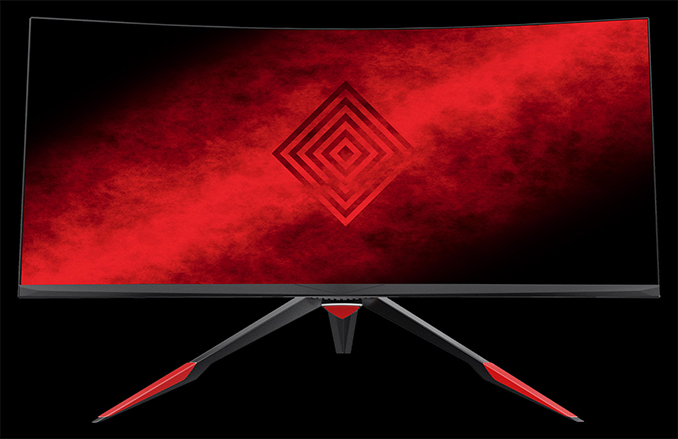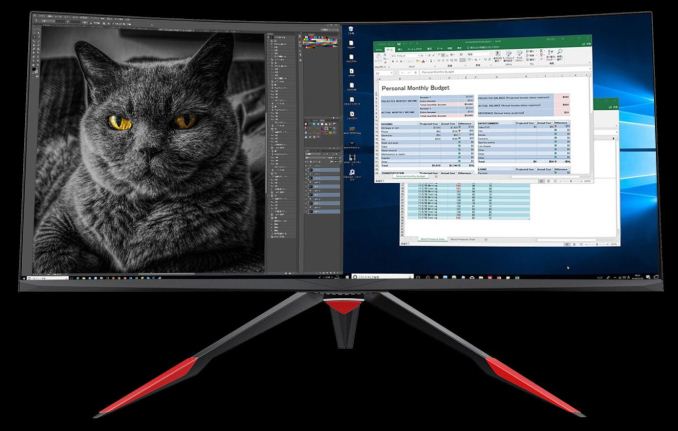JapanNext Launches 35-Inch "UWHD" Curved LCD: AMVA & 200Hz Refresh w/FreeSync
by Anton Shilov on August 7, 2018 8:00 AM EST
JapanNext this month has introduced its new 35-inch ultrawide curved gaming display. The tounge-twistingly named JN-35VCG200UWHD features a 2560x1080 "UWHD" resolution, a very low response time, as well as a FreeSync-enabled dynamic refresh rate of up to 200 Hz. The combination of features that the LCD supports is rare, but not particularly unique, meanwhile a good thing about this product is that it is more than 30% cheaper than its immediate rival.
The JapanNext JN-35VCG200UWHD is based on a 35-inch AMVA3 panel with a 2560×1080 resolution, a 21:9 aspect ratio and a 1800R curvature. General specs of the monitor are fairly standard: 300 nits brightness, 2000:1 contrast ratio, 178°/178° viewing angles, 16.7 million colors, 3 ms response time (grey-to-grey), and so on. The key features of the display are AMD’s FreeSync dynamic refresh rate technology as well as the LCD’s massive 200 Hz refresh rate particularly welcome by gamers. JapanNext does not officially disclose the FreeSync range for the monitor, but I wouldn't be surprised if it was between 30 and 200 Hz, thus supporting low framerate compensation feature (LFC) and offering smooth gameplay across different genres.
To actually hit 200 Hz at 2560×1080 owners will need to use a DisplayPort 1.2 or an HDMI 2.0 input. Meanwhile, to maintain compatibility with legacy PCs, the JN-35VCG200UWHD also has a DVI-D connector. Since owners will likely use their 35-incher with multiple PCs at once, the LCD also supports PiP and PbP capabilities, but only at 60 Hz.
Since the JapanNext JN-35VCG200UWHD is aimed at gamers, it comes in a chassis featuring an aggressive design with red inlays and 1-cm bezels to make it easier to assemble a multi-display setup using two or three monitors. Furthermore the LCD supports various presets for different types of game genres.
The only direct rival of the JapanNext JN-35VCG200UWHD is the AOC AGON AG352QCX, which was released in late 2016 and has similar features. In fact, the LCD from JapanNext has a slightly better panel and a lower response time.
The JapanNext JN-35VCG200UWHD display will be available in Japan at an MSRP of ¥89,980 ($808), which is 32% lower than $1,185, the price of the AOC AGON AG352QCX at Amazon. As an added kicker, for a limited time JapanNext will offer the new ultrawide display at a discounted price of ¥69,980 ($629). Considering the unique combination of features offered by the monitor, it is unlikely that JapanNext needs to sell it at a loss just to attract attention of early adopters. That being said, it looks like 35-inch ultrawide curved display with WFHD resolution and an up to 200 Hz refresh rate have a lot of room for price reductions.
| JapanNext's Curved Display with a 200 Hz Refresh Rate | |
| JN-35VCG200UWHD | |
| Panel | 35" AMVA |
| Native Resolution | 2560 × 1080 |
| Refresh Rate Range | 30-200 Hz (DP, HDMI) 60 Hz (DVI) |
| Response Time | 3 ms |
| Brightness | 300 cd/m² |
| Contrast | 2000:1 |
| Viewing Angles | 178°/178° horizontal/vertical |
| Curvature | 1800 R |
| Pixel Pitch | 0.2382 mm |
| Inputs | 1 × DP 1.2 1 × HDMI 2.0 1 × DVI |
| USB Hub | - |
| Audio | - |
| Power Consumption | Max: 60 W Typ: 40 W Idle: 0.5 W |
Related Reading:
- AOC Launches the AG352QCX: 35-Inch 200 Hz 2560×1080 Curved Display with Adaptive-Sync
- Acer Predator X35 & ASUS ROG Swift PG35VQ Unveiled: 35-inch G-SYNC HDR Monitors - UltraWide, Curved, 200Hz
- JapanNext JN-VC490UHD and JN-VC550UHD: 49-55 inch, Curved 4K, FreeSync, HDCP 2.2, Under $900
- ASUS Announces ROG Strix XG32VQ and ROG Strix XG35VQ: Large, Curved, & Fast
- ASUS ROG Strix XG27VQ Available: 27” Curved, FHD@144Hz & FreeSync w/ELMB
- LG’s 34UC89G 21:9 Curved Display with G-Sync, 144 to 166 Hz, Available for $999
Source: JapanNext (via Hermitage Akihabara)












21 Comments
View All Comments
DanNeely - Tuesday, August 7, 2018 - link
Or they're using a much lower quality panel and you get what you pay for.JoeyJoJo123 - Tuesday, August 7, 2018 - link
>Or they're using a MUCH LOWER QUALITY PANEL and you get what you pay for.I'm not sure you know how the monitor manufacturing business works. In most cases, there isn't such a thing as a "much lower quality panel", there's literally just a handful of panel manufacturers. And in most cases for high refresh rate panels, AUO (AU Optronics), is the only player on the market.
According to TFT Central:
http://www.tftcentral.co.uk/articles/monitor_panel...
AUO AMVA M350DVR01.2 2560x1080 2000:1 300 172/178 16.7m sRGB W-LED 200Hz 21:9 2000R
It's possible the 1800R curvature is either a new model panel, or that the product's specs are wrong on the manufacturer's page, or something, but even so you'd see that all the 35" panels (especially ones touting "AMVA" technology, which is AU Optronic's particular flavor of VA style LCD displays) are being manufactured by AUO, which is also the same manufacturer of the panels used in the $2K GSync 4k 144hz monitors on the market.
Here's the thing, the panels being used here aren't any lower quality, they're made by the same panel manufacturer. This means one of two things:
a) AUO has dramatically increased yields and production capacity of this particular panel and JapanNext can buy these at a lower cost than ever before and JapanNext is passing those savings onto the customer. (Unlikely)
b) AUO is selling B-stock (panels which may not meet stricter standards of more well known monitor sellers, this is what the "cheap korean monitor" market is founded on) panels to JapanNext, JapanNext weeds out the few nonfunctional or bad monitors from the pallets of panel B-stock that wasn't sold to bigger brands, and after QAing the B-stock, the monitors they sell end up being defect free anyways, like the vast majority of Korean monitors. (Extremely likely)
c) JapanNext is trying to be a loss leader for this very specific monitor so that they gain marketshare or user recognition. (Unlikely)
Chances are that the monitors here aren't any better or worse than big name brands. They're likely just buying up remaining panels not being bought by bigger brands as bulk b-stock at much lower prices and they're able to integrate these into monitors and sell them for a lower price as a result.
DanNeely - Tuesday, August 7, 2018 - link
Binning is what I mean by lower quality, and panel makers bin them into a lot more than just the 2 bins your b stock comment refers to. IIRC typically 5-10 bases on dead/stuck pixels, backlight bleed/consistency issues, etc. The absolute top tier probably doesn't exist for these panels since that normally goes to NEC and Ezio for profesional grade monitors at 50-150% above normal consumer prices. The spread in mainstream tiers is why within a more broadly based product class the premium tiers generally have better quality screens not just more adjustable stands.Normally the bottom tiers go to digital display companies because no one can notice dead pixels or uneven backlights on a screen installed 10 feet above their head at the local fast food place. The cheap Korean monitors were basically just skimming off and rebadging some of those and sticking a basic consumer stand on the back instead of a bare vesa mount to get screwed into the wall. Curved panels aren't really useful for that, so I suspect the QC rejects that would normally go to your local burgermart are even cheaper than normal. Until people start testing retail samples I'd be concerned about quality if that's the case because there's nowhere other than budget gaming displays to dump the worst of the worst short of a landfill.
Glaurung - Tuesday, August 7, 2018 - link
"the panels being used here aren't any lower quality, they're made by the same panel manufacturer. This means one of two things:"Other ways they could be cutting costs include not calibrating the panels, and/or skimping on connectors and other niceties for the enclosure. Oh, and less of a warranty.
B-grade panels are the most likely explanation, I agree.
Valantar - Tuesday, August 7, 2018 - link
Nice to see more ultrawide options appear, but I'm never going near anything with 1080 vertical pixels unless it's a <=15" laptop. Make it 1440p @ 100-144hz, please.Beaver M. - Tuesday, August 7, 2018 - link
1080 vertical pixels on a 35" monitor is eye cancer...mobutu - Tuesday, August 7, 2018 - link
This should have been AT LEAST 2560x1440piroroadkill - Wednesday, August 8, 2018 - link
That would give rectangular pixels. An odd choice for a computer monitor.Dug - Thursday, August 9, 2018 - link
I think he's referring to aspect ratio and vertical size. 2560 x 1440 is very popular for a computer monitor.nimi - Wednesday, August 8, 2018 - link
"Aimed at gamers".Proceeds to include in their press shots a screenshot of Photoshop and Excel open.